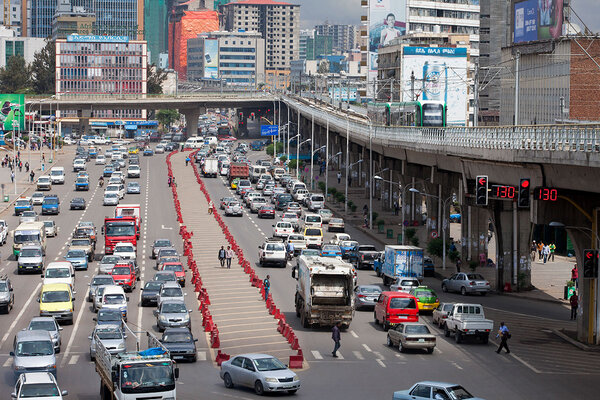The country’s booming capital, Addis Ababa, sits in stark contrast to rural areas struggling against two severe droughts in three years. But innovative aid has helped farming communities manage the crisis.
Ryan Lenora Brown
GODE, ETHIOPIA—Battered by drought and civil wars, more than 20 million people from Yemen to Tanzania are at risk of starvation in what aid workers call the largest humanitarian crisis since World War II. But over the past two decades, nations that once produced searing images of famine’s toll have moved to thwart it by strengthening community resilience. Our reporters traveled to Madagascar, Ethiopia, and Somaliland to investigate the daunting challenges as well as the long-term efforts that are saving lives.
Addis Ababa is hungry. These days, Ethiopia’s capital seems to need more of almost everything: land for factories, shopping malls and highways; steel and concrete to build new skyscrapers; lanky rods of eucalyptus to scaffold their skeletons as they rise. Addis needs more roads, schools, houses, and cars. It needs apartment buildings for its migrants, and five-star hotels for the unending parade of diplomats attending African Union meetings in the glossy new Chinese-bankrolled headquarters at the center of town. The city fills out and up, seemingly insatiable, nibbling into surrounding farmland and poking higher and higher into the smoggy highland sky.

Vehicles pass through Meskel Square beside the elevated tracks of the modern light rail in downtown Addis Ababa, Ethiopia, the capital of one of the world’s faster-growing economies.
Melanie Stetson Freeman/Staff
Six hundred miles to the southeast, meanwhile, Ethiopia’s Somali region is hungry, too – or more accurately, it is thirsty. It hasn’t rained here – at least, not enough – in more than a year, and more rain isn’t expected until October. It’s already been long enough that grazing lands have grown huge bald spots, and intake at pediatric malnutrition wards has doubled. It’s long enough that ribs ripple visibly beneath the skin of those few cows and camels that have survived, and long enough to leave thousands of young people stranded in romantic purgatory: engaged, in love, but without the money to pay yarad, the traditional Somali bride price.
Unlike in Addis, where old Soviet Ladas jostle for space with high-end SUVs on traffic-clogged streets, practically the only vehicles on the roads here are ancient, bug-eyed Mercedes cargo trucks carting water and food aid into remote towns. This is the second severe drought to hit the country in three years, and government and humanitarian agencies estimate that nearly 8 million Ethiopians are currently in urgent need of humanitarian assistance – a figure that is expected to grow amid the dry season, which began in July.

“I’m 80 years old and I’m telling you that I have never seen a drought like this before,” says Abdullahi Abdi, a resident of Melkaselah, a windswept village in the Somali Region. “It has not rained here in 22 days.”
Melanie Stetson Freeman/Staff
“I’m 80 years old and I’m telling you that I have never seen a drought like this before,” says Abdullahi Abdi, a resident of a windswept Somali region village called Melkaselah, resting his orange henna-tinted beard on a walking stick. It has not rained here in 22 days, he says, at a time of year when the rains should come two or three times a week. “All of our livestock are gone.”
For decades, Ethiopia was synonymous in many Westerners’ minds with scenes like this one, the kind splashed across the world’s front pages during the infamous famines of the 1970s and ‘80s and immortalized in pop music by the cringe-worthy “Do They Know It’s Christmas?” (Suffice to say, in one of the world’s oldest Christian societies, they probably did.)
But now, Ethiopia’s image looks a lot more like its capital city: gleaming, cosmopolitan, and boldly aspirational. Although still a nation of farmers, for the past decade, this has been among the world’s fastest growing economies. It has used that brisk development to slash illiteracy, disease, and extreme poverty – though by methods undemocratic and at times aggressively repressive.
And if Ethiopia was once the world’s poster child for drought mismanagement, it is now the regional model for early warning and nimble response. As two of the worst droughts in recorded history have swept across the country, a muscular, government-led reaction has driven back the crisis to mostly manageable levels – even as in neighboring South Sudan and Somalia, the same weather conditions have brought populations to the edge of famine.
To read more click here
Source: The Christian Science Monitor


